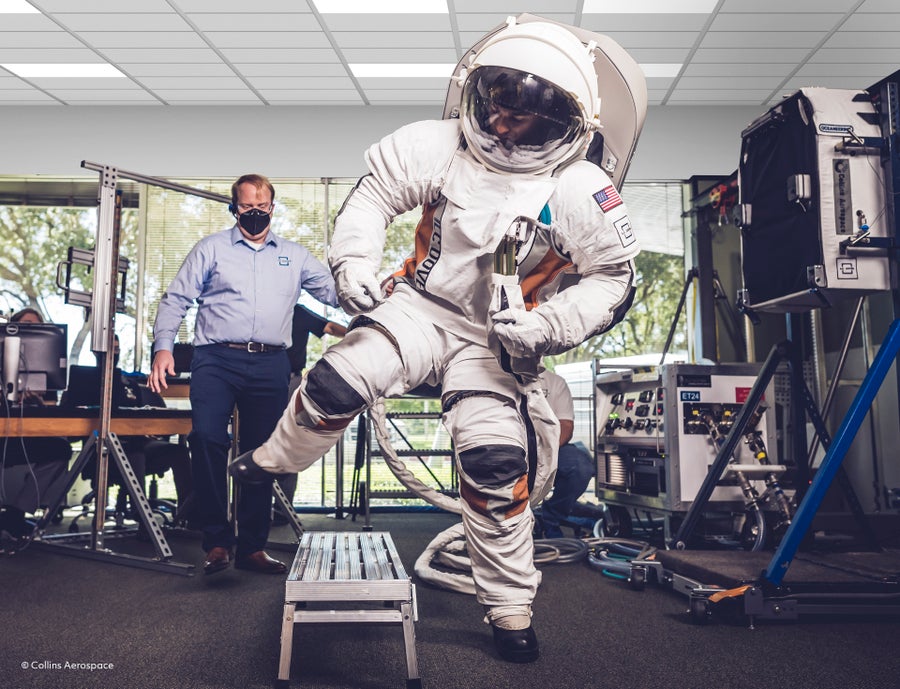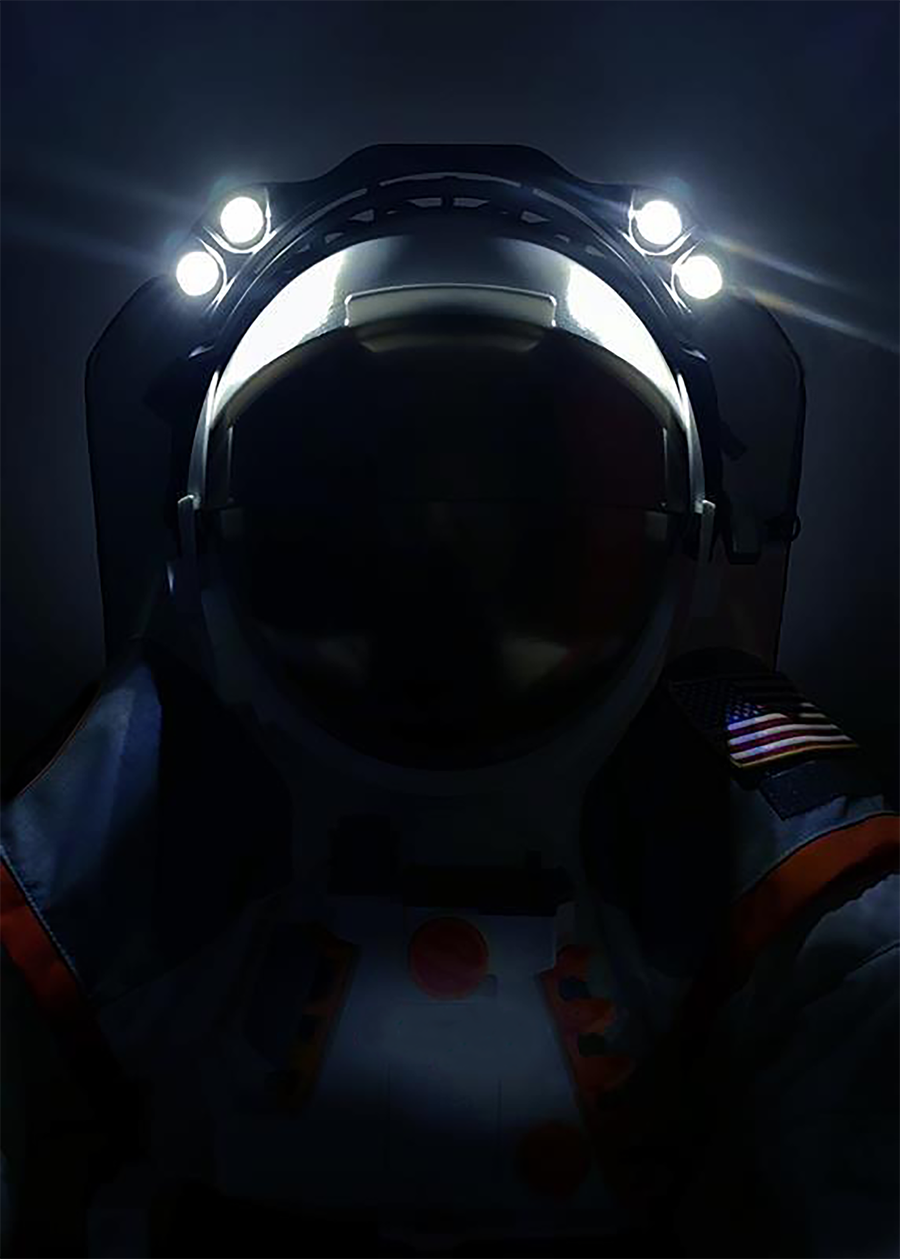Sooner or later, humans will set foot on the moon again—perhaps by the middle of this decade if NASA’s Artemis program proceeds as planned. And beyond that, public or private crewed missions to Mars in the 2030s or 2040s no longer seem solely confined to science fiction. But what will astronauts be wearing when they take those steps on other worlds? Procuring giant rockets and futuristic spacecraft for Artemis has been the most well-publicized hurdle for NASA to overcome, but its efforts to design new spacesuits for the moon have proved equally challenging. Since 2007 the space agency has spent an estimated $420 million on new suit designs without actually fielding any. Finally, after all those unsuccessful attempts, last month NASA announced it has opted to outsource the work and has selected two companies to craft the next generation of haute couture for the high frontier.
Those companies—Axiom Space in Texas and Collins Aerospace in North Carolina—will each independently develop new spacesuits as part of NASA’s Exploration Extravehicular Activity Services (xEVAS) contract. NASA has budgeted a total of $3.5 billion through 2034 for that combined work and plans to purchase its suits from the two companies as a service, which will free both to make and market additional suits for non-NASA commercial missions as well. Following demonstrations of the suits in Earth orbit, they will be used for the first Artemis landing, which is currently scheduled for 2025. That mission, dubbed Artemis III, will feature two astronauts, one man and one woman, who will don suits from one of the two companies to venture out onto the lunar surface. Whichever company isn’t chosen for that first landing will instead supply suits for later Artemis missions.
“This is a historic day for us,” said Vanessa Wyche, director of NASA’s Johnson Space Center, in a press conference announcing the award on June 1. “History will be made with these suits when we get to the moon.”
On supporting science journalism
If you're enjoying this article, consider supporting our award-winning journalism by subscribing. By purchasing a subscription you are helping to ensure the future of impactful stories about the discoveries and ideas shaping our world today.
Troubled Development
The selection of these two companies followed a 2021 call put out by NASA for new spacesuit proposals because the existing Extravehicular Mobility Unit (EMU) suit used on the International Space Station (ISS) is too bulky and rigid for lunar-surface forays. More than 40 companies registered their interest, including SpaceX and Blue Origin, but only Axiom and Collins submitted finished proposals by the December 2021 deadline. In a source selection statement released later in June, NASA gave high ratings to both Axiom’s proposed suit, called the AxEMU, and the currently unnamed suit proposed by Collins.
By design, this public-private partnership will allow both suit manufacturers to also offer their services outside the space agency, potentially to visitors to private space stations such as one Axiom is currently developing. “Axiom will use the AxEMU to support all of our customers,” says Mark Greeley, Axiom’s xEVAS Program Manager. “The AxEMU is capable of supporting [spacewalks] in any environment our customers desire,” he says. Collins is planning for the same. “We don’t want this just to be a bespoke design for NASA,” says Dan Burbank, senior tech fellow at Collins and a former astronaut. “This should be a commercially appropriate suit that will meet the needs of private astronauts as well.”

Personnel perform mobility tests for a prototype of the Collins Aerospace spacesuit in a company facility. Credit: Collins Aerospace
Getting to this stage has been an arduous process. In 2012 NASA unveiled its Z-1 prototype spacesuit, which bore a green-and-white design that could have made future moonwalkers resemble Buzz Lightyear. It was later redesigned as the Z-2, but development stalled. In 2019 NASA presented its attempt intended for the Artemis missions, dubbed the Exploration Extravehicular Mobility Unit (xEMU), but an audit by the agency’s Office of Inspector General found the suits would not be ready for the Artemis landings; it cited lingering issues with costs and technical problems. “There was concern that this was a never-ending and unsustainable process,” says Cathleen Lewis, a space historian at the National Air and Space Museum in Washington, D.C. That doesn’t mean NASA’s in-house spacesuit pursuits will go to waste—both Axiom and Collins will have access to all of that previous work. “They could decide how much of NASA’s designs they wanted to use,” says Lara Kearney, manager of the Extravehicular Activity and Human Surface Mobility Program at NASA’s Johnson Space Center in Texas.
The exact designs of the two companies’ spacesuits are still under wraps. The selection process dictated that both of them had to show their suits could meet about 80 requirements set by NASA, however. “We then left it open to them to decide what their design looked like,” Kearney says. These requirements relate to the unique objectives of the Artemis missions and their intended difference from the Apollo missions of the 1960s and 1970s. Artemis astronauts will spend more time than their predecessors on the lunar surface and will explore more diverse locations, including the dark depths of craters that could contain water ice. Those aspirations demand more mobility than the awkward waddling and clambering provided by the Apollo program’s suits and more adaptability, too: instead of serving an all-male (and all-white) cadre of moonwalkers, the new suits must meet the needs of NASA’s far more diverse modern astronaut corps. “We have to think about diversity,” says Amy Foster, a space historian at the University of Central Florida. “I don’t want anybody being cut out of the opportunity to fly on Artemis because their body type doesn’t fit a suit.”
Versatile and Built to Last
Among the requirements, the suits need to allow at least six lunar-surface excursions to be conducted per mission. At least one will occur per day, and each will last more than eight hours. Astronauts must be able to enter and exit the suits without assistance, and the total prep time for venturing outside a lander or habitat must be no more than 90 minutes.
Both Axiom and Collins are designing their suits to be rear-entry. This means that rather than putting a suit on within an airlock and then exiting a spacecraft, as is done with spacesuits currently on the ISS, these new designs could be attached externally to a special NASA-prototyped airlock called a suit port. “You could literally back into a hatch, bond the outer portion of your [suit] to this structure and then open the hatch,” Burbank says. This helps reduce the amount of potentially harmful lunar regolith, or moon dust, that is tracked back inside. Using a suit port “eliminates the regolith hazard,” Burbank says. “None of the exterior of the suit sees the interior of the spacecraft.”

Illustration of Axiom Space’s Extravehicular Mobility Unit (AxEMU) spacesuit, which the company is currently developing in Houston, Texas. Credit: Axiom Space
Reflecting in part NASA’s objective for Artemis to send the first people of color and the first women to the moon, the new suits must, in a sense, also be “one-size-fits-all”—capable of interchangeable use across multiple missions by a diverse group of astronauts with a wide range of physiques. Each suit must allow for 90 percent of the male and female population to wear it, which includes anyone as short as four feet, 10 inches (1.5 meters) or as tall as 6 feet, four inches (1.9 meters) with a weight of 94 to 243 pounds (42 to 110 kilograms). “NASA tried to do an all-women spacewalk [in 2019] and they had to keep postponing it because they didn’t have the right-sized suits,” says Michael Lye, a spacesuit designer at the Rhode Island School of Design. “The new suits by Axiom and Collins will fit a much wider variety.” How both companies plan to meet this requirement is currently undisclosed.
Another key objective of the Artemis missions is to collect plenty of samples for subsequent study. The suits must have accessories to achieve this goal, including hammers, rakes, chisels and handheld flashlights. They are also intended to be extremely maneuverable and incorporate a movable torso and joints that will allow astronauts to move more naturally across the low-gravity, rugged lunar landscape. “During the Apollo days, there was no ability to allow your hips to move counter to your shoulders,” Burbank says. “You literally could not take your hips out of alignment with your shoulders. You can do that with this spacesuit.” The suits will also have a lower mass than Apollo-era designs, making them easier to use for extended periods. “I’ve done push-ups in the new suit,” Burbank says. “That would be unimaginable in the existing suits we have right now.”
Uncharted Waters
NASA has plenty of other high bars for the suits to hit, some of them unprecedented. They must not subject the astronauts to any sounds above 115 decibels, comparable to the noise made by a leaf blower. They must be sturdy enough to bring the chance of micrometeoroids piercing the exteriors down to just one in 2,500. Inspired by the ceremonial unfurling of American Stars and Stripes by each set of Apollo moonwalkers (and the difficulty of hammering poles into the surprisingly tough lunar terrain), the suits must include tools to help Artemis crew members carry and plant a flag. And stomach-churningly, the suits must be able to somehow clear up to half a liter of vomit from a moonwalker’s eyes, nose and mouth in the event that they regurgitate inside their helmet.

Illustration of an astronaut clad in a Collins Aerospace spacesuit on the lunar surface. Credit: Collins Aerospace
The suits must also remain functional after being left on the lunar surface—initially for 210 days as per NASA’s requirements but eventually for as long as three years. This could allow astronauts on future missions to revisit previous landing sites and reuse the suits left behind rather than having to bring their own. “Depending on the landing sites, we could be able to go and collect and reuse them,” Kearney says. Both Axiom and Collins are also looking at additional technologies to include inside the suits, such as digital heads-up displays inside the helmet. “The vision we have is to display information to the crewmember about the health of the suit, health of themselves and [crewmates], path to their rover, all those kinds of things,” Burbank says. “You could have the ability to interweave infrared imagery as well.”
Perhaps most importantly, the suits must be designed for a bold new era of lunar exploration. The Apollo missions conservatively focused on the sunlight-bathed equatorial regions of the near side of the moon, but Artemis missions will venture into more daunting locales at the moon’s south pole. Here astronauts may explore some of the moon’s permanently shadowed regions (PSRs)—craters angled in such a way that the sun never reaches their depths. Inside, temperatures can plunge to –400 degrees Fahrenheit (–240 degrees Celsius), twice as cold as the lowest surface temperatures found elsewhere on the moon during its two-week-long lunar night. Observations from lunar orbit have shown that PSRs are probably rich in water ice, either frozen on the surface or mixed into the lunar soil, which could be accessed and used as drinking water or rocket fuel. NASA has required that the new suits could operate in these frigid locations for at least two hours, which will give astronauts a chance to prospect there.
“There’s hundreds of millions of tons of water ice buried in relatively shallow depths at the south pole,” Burbank says. “Water for human presence on the moon is essential. So you’re going to need spacesuits to actually do the resource extraction.”
It is not just the moon where astronauts may don these garments. Per NASA’s instructions, both are being designed with future modifications for eventual missions to Mars in mind. “The AxEMU is heavily architected to support Martian [extravehicular activities],” Greeley says, noting that while “some development remains,” the company is investigating how to cope with that planet’s tenuous atmosphere and its more substantial gravitational field. First up, though, will be the frenzied-but-methodical sprint to prepare the suits’ lunar variants for that first, long-awaited Artemis moon landing. Development delays with the requisite rockets may make that notional 2025 deadline slip, of course—which could be for the best because readying such ambitious suits in such a short time frame seems challenging, to say the least. “There’s a lot of work to be done,” Lewis says. But whenever humans do set foot on the moon again, that work should ensure they have shiny new garments to do it in, vomit removal system and all.
